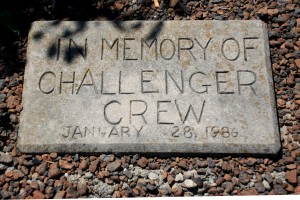My office is located in a former elementary school building. For the most part, the building stands as it was when it was sold by the school district ten years ago. A few of the old classrooms have been upgraded with drywall and wood trim, but mostly, the rooms resemble my office: painted cinder block walls, bland single-color VCT floors, remnants of the intercom system still in place, a horribly inefficient heating-and-cooling system. So, it shouldn’t surprise me to see signs of the building’s former life, but this one, in a flower bed next to a door I seldom use, caught me unaware last week.
Space shuttle Atlantis is in its final stages of waiting on Launch Pad 39A at Kennedy Space Center for the beginning of STS-135 on July 8. I’m not superstitious enough to take my sudden notice of the plaque as some sort of omen—I work with the history of astronomy and space exploration every day, so odds are that it would have seemed significant to me, no matter when I saw it—but I will say it did cause me to rehearse (again) 25 years of space shuttle history in mental preparation for the upcoming launch. Many lives were changed in dramatic and still almost incomprehensible ways with the lost of Challenger. The end of the space shuttle program will also bring change, of course, but let’s hope for something more incremental and a lot less painful for everyone involved.
For more information on Friday’s launch, visit NASA’s space shuttle page for a mission brief, press kit and more.
